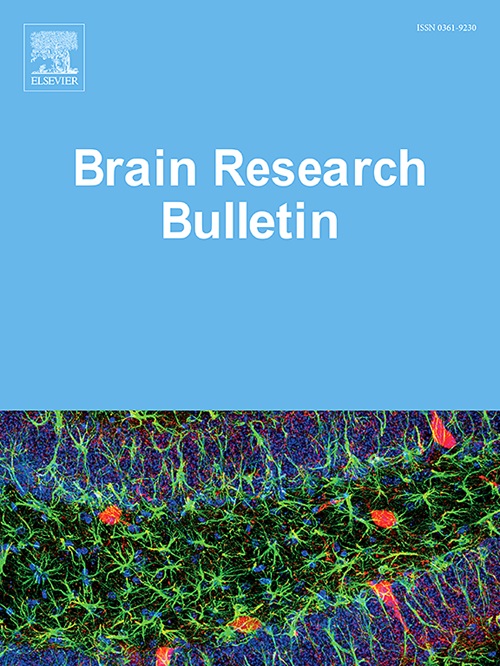Altered functional network topology properties to detect anxiety and depression caused by Crohn’s disease and disease severity
IF 3.5
3区 医学
Q2 NEUROSCIENCES
引用次数: 0
Abstract
Objective
Here we investigated changes in topological properties of functional brain networks among individuals with Crohn’s disease (CD) and to determine whether these changes are related to CD severity, as well as CD-associated anxiety and depression, which are regulated by the brain–gut axis mechanism.
Methods
In total, 31 individuals with CD, 21 with irritable bowel syndrome (IBS), and 20 healthy controls underwent functional magnetic resonance imaging. Individuals with CD or IBS were also evaluated using the Hospital Anxiety and Depression Scale-Anxiety (HADS-A) and Depression (HADS-D) scales, as well as the simple endoscopic score for CD (SES-CD). Graph theory-based methods were applied to calculate the topological properties of brain networks, and comparisons among the three groups were performed using one-way analysis of variance. Partial correlation analysis was used to assess correlations among these properties and HADS-A, HADS-D, and SES-CD scores.
Results
In the CD group, altered global topological properties were identified, and altered local topological properties were observed in 13 brain regions. The functional connectivity (FC) between the default mode network and visual network was increased, and the FC in the limbic system was decreased. In the CD group, local topological properties in the amygdala and precuneus were negatively correlated with HADS-A scores, and local topological properties in the superior occipital gyrus were positively correlated with SES-CD scores.
Conclusion
Both global and regional topologies of brain networks were impaired in individuals with CD, which were correlated with clinical scores, suggesting that these values could serve as neuroimaging metrics reflecting the degree of anxiety caused by CD and CD severity.
改变功能网络拓扑特性检测由克罗恩病和疾病严重程度引起的焦虑和抑郁
目的:研究克罗恩病(CD)患者脑功能网络拓扑特性的变化,并确定这些变化是否与CD严重程度以及与CD相关的焦虑和抑郁有关,这些变化是由脑肠轴机制调节的。方法:对31例CD患者、21例肠易激综合征(IBS)患者和20例健康对照进行功能磁共振成像。患有乳糜泻或肠易激综合征的个体也使用医院焦虑和抑郁量表-焦虑(HADS-A)和抑郁量表(HADS-D)以及简单的内窥镜乳糜泻评分(SES-CD)进行评估。采用基于图论的方法计算脑网络的拓扑特性,并采用单因素方差分析对三组进行比较。偏相关分析用于评估这些属性与HADS-A、HADS-D和SES-CD评分之间的相关性。结果:在CD组中,发现了整体拓扑性质的改变,并在13个脑区观察到局部拓扑性质的改变。默认模式网络与视觉网络之间的功能连通性增加,边缘系统的功能连通性降低。在CD组中,杏仁核和楔前叶局部拓扑特性与HADS-A评分呈负相关,枕上回局部拓扑特性与SES-CD评分呈正相关。结论:乳糜泻患者大脑网络的整体和区域拓扑结构都受损,这与临床评分相关,表明这些值可以作为反映乳糜泻引起的焦虑程度和严重程度的神经影像学指标。
本文章由计算机程序翻译,如有差异,请以英文原文为准。
求助全文
约1分钟内获得全文
求助全文
来源期刊

Brain Research Bulletin
医学-神经科学
CiteScore
6.90
自引率
2.60%
发文量
253
审稿时长
67 days
期刊介绍:
The Brain Research Bulletin (BRB) aims to publish novel work that advances our knowledge of molecular and cellular mechanisms that underlie neural network properties associated with behavior, cognition and other brain functions during neurodevelopment and in the adult. Although clinical research is out of the Journal''s scope, the BRB also aims to publish translation research that provides insight into biological mechanisms and processes associated with neurodegeneration mechanisms, neurological diseases and neuropsychiatric disorders. The Journal is especially interested in research using novel methodologies, such as optogenetics, multielectrode array recordings and life imaging in wild-type and genetically-modified animal models, with the goal to advance our understanding of how neurons, glia and networks function in vivo.
 求助内容:
求助内容: 应助结果提醒方式:
应助结果提醒方式:


